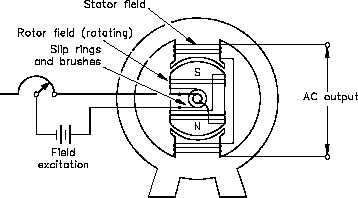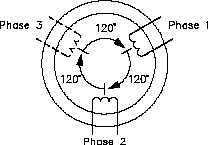AC Generators
AC GENERATOR OPERATION
If DC field excitation is connected
Figure 6 Simple AC Generator - Rotating Field, Stationary
Armature
to the rotor, the stationary coils
will have AC induced into them
(Figure 6). This arrangement is
called a rotating field, stationary
armature AC generator.
The rotating field, stationary
armature type AC generator is
used when large power generation
is involved.
In this type of
generator, a DC source is supplied
to the rotating field coils, which
produces a magnetic field around
the rotating element. As the rotor
is turned by the prime mover, the
field will cut the conductors of the
stationary armature, and an EMF
will be induced into the armature windings.
This type of AC generator has several advantages over the stationary field, rotating armature AC
generator: (1) a load can be connected to the armature without moving contacts in the circuit;
(2) it is much easier to insulate stator fields than rotating fields; and (3) much higher voltages
and currents can be generated.
Three-Phase AC Generators
Figure 7 Stationary Armature 3f Generator
The principles of a three-phase generator are basically
the same as that of a single-phase generator, except
that there are three equally-spaced windings and three
output voltages that are all 120° out of phase with
one another. Physically adjacent loops (Figure 7) are
separated by 60° of rotation; however, the loops are
connected to the slip rings in such a manner that
there are 120 electrical degrees between phases.
The individual coils of each winding are combined
and represented as a single coil. The significance of
Figure 7 is that it shows that the three-phase
generator has three separate armature windings that
are 120 electrical degrees out of phase.
Rev. 0
Page 11
ES-10






